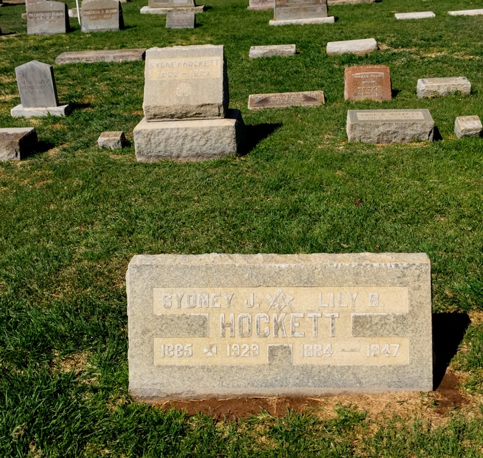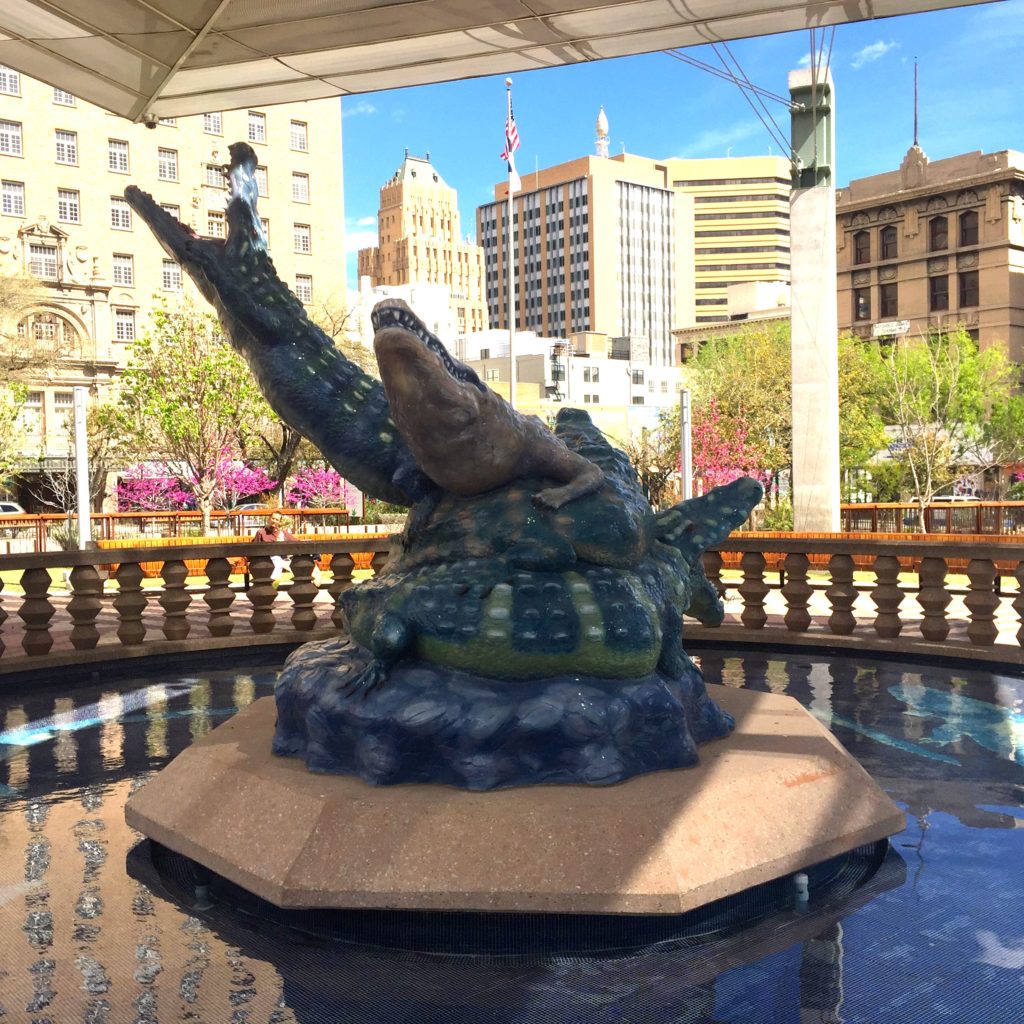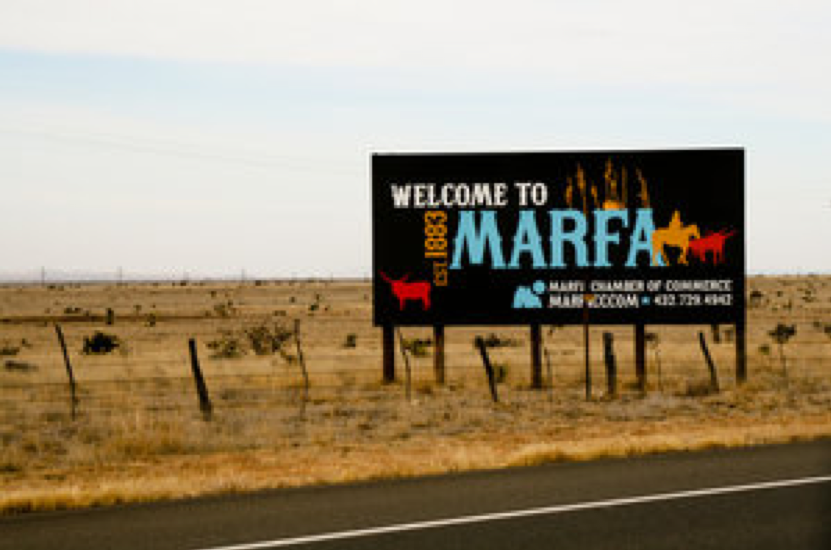
Following the Civil War, the west was untamed and expanding. On the Texas frontier the saying was “West of the Pecos there is no law. West of El Paso there is no God.” This was the wild west of Judge Roy Bean, the Buffalo Soldiers, and Quanah Parker and his Comanche warriors.
Today, little more than 100 years later, the biggest little attraction in this vast high desert landscape is Marfa, population 1747. Lying 400 miles west of San Antonio and 200 miles east of El Paso, Marfa is a magnet for fans of the cutting edge minimalist art of Donald Judd, the New Yorker who came here in 1971 intent on taking his art out of the galleries and museums in order to implement a larger vision.
Last month, on our Grand Tour of Texas, we pulled our big white Suburban up to the Hotel Paisano after a disappointing visit to Huecos Tanks State Park where we waited for hours to see what turned out to be graffiti-covered pictographs. Nevertheless, undeterred, the Lasaters and Bernards were ripe for a couple days of modern art in the middle of nowhere.
It seems Marfa was destined to be an artistic destination from the beginning. According to Darwin Spearing’s Roadside Geology of Texas, the town was given its name by the wife of Southern Pacific Railway’s chief engineer. She was reading Dostoyevski’s Brothers Karamazov as she passed through town, and Marfa was the name of one of the Karamazov servants. If you don’t like that one, other sources claim the town was named for Marfa Strogoff, a character in Jules Verne’s novel Michael Strogoff. Either way, this little West Texas town has an established literary pedigree.
For a small town with literary antecedents and world famous art, it’s not surprising that its hotel has a star laden past as well. The Hotel Paisano broke ground only days before the 1929 stock market crash and it’s history is full of boom/bust stories. In 1955, it was headquarters for the cast and crew of the classic movie Giant starring James Dean, Elizabeth Taylor and Rock Hudson and today its hallways are lined with large photos from the film’s archives. Shortly after the Giant crew left town, the Paisano fell on hard times but was saved from demolition in 1978 when it was placed on the National Register of Historic Places .
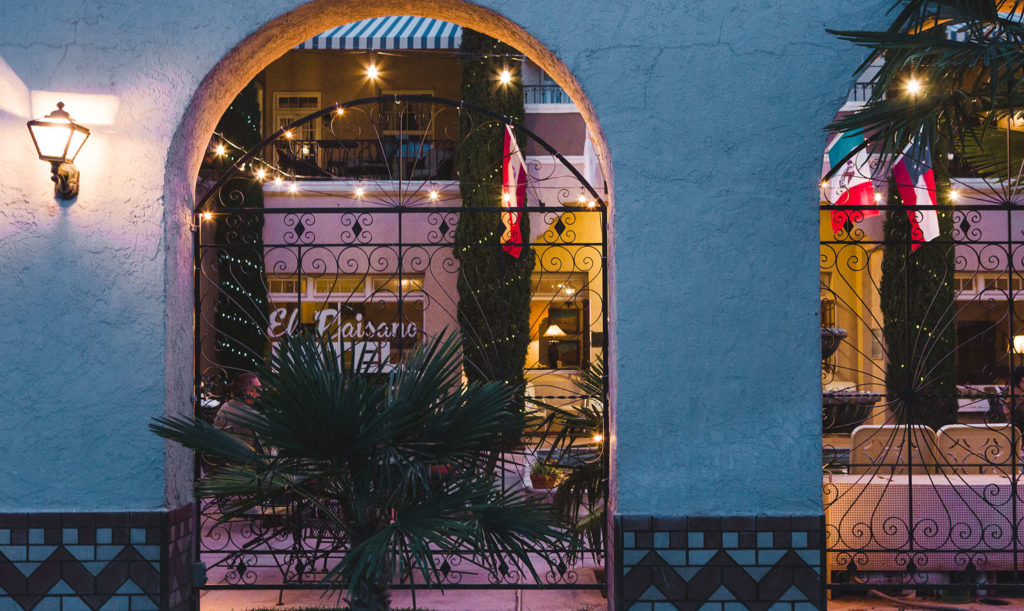
Today, the hotel is completely renovated and restored to its original state with tile floors, a courtyard fountain and lots of cowboy and Giant movie memorabilia.
On our first morning in town, following coffee in the lobby , we met our guide, Sterry Butcher, a local who works for the Chinati Foundation and writes a column for Texas Monthly. She’s the real deal, and because the foundation is closed on Monday and Tuesday we arranged to have her give the four of us a private tour of Donald Judd’s world at Chinati.
The town’s modern day reputation is due to Donald Judd, the New York artist who “discovered” Marfa in 1971 and moved there permanently in 1973. There, he partnered with a non-profit foundation to purchase an abandoned Army base, including its buildings, as the locus for his art – first, a series of 15 concrete boxes arranged along a north-south axis in the field adjoining the Army barracks and then 100 milled-aluminum boxes arranged in two remodeled artillery storage structures nearby.
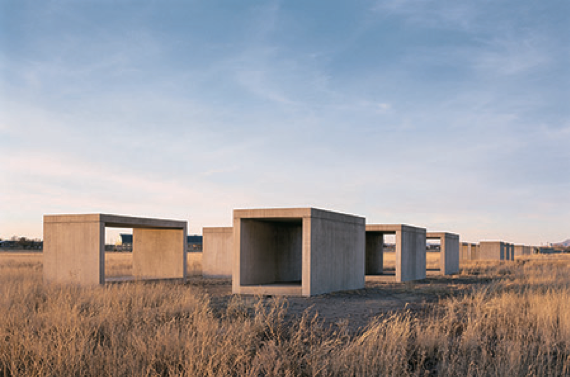
Donald Judd died in 1994, but by then he had established his site plan and begun populating it with the art of his expansive vision.
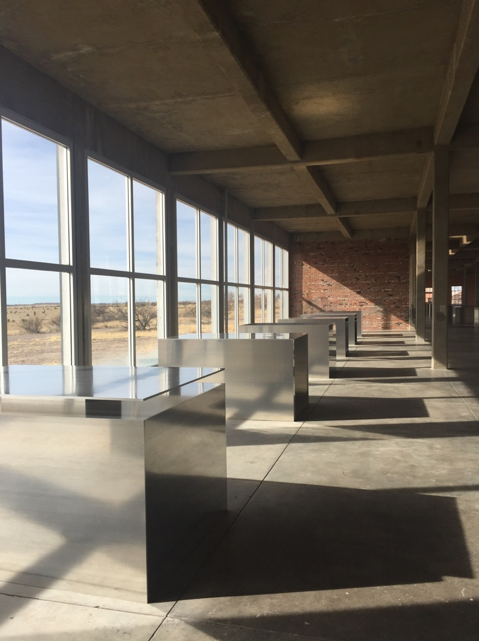
While it’s true that Marfa’s artistic reputation is due Judd’s vision, that vision was not entirely self-referential. He admired the work of many other artists and envisioned an environment in which his friends could exhibit their work in discreet spaces on the same property. He accomplished that by renovating several U-shaped barracks buildings and inviting several friends – Dan Flavin, Bridget Riley, Carl Andre, Robert Irwin, Claes Oldenburg and others – to each take a building and create a work of art.
Here are examples from Bridget Riley, Dan Flavin, and Robert Irwin:
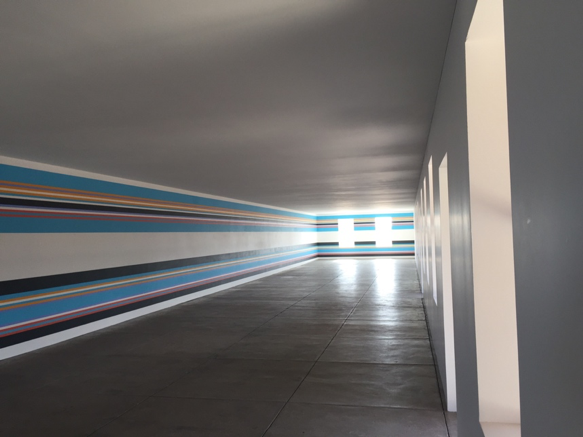
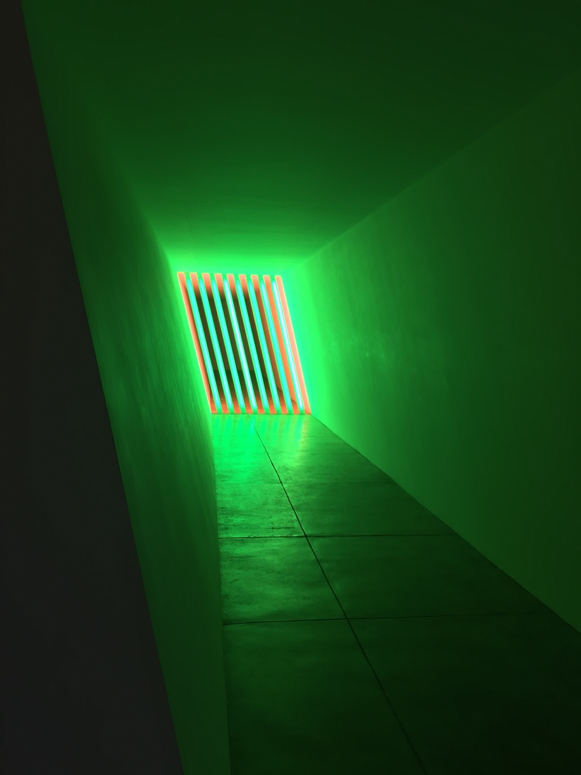
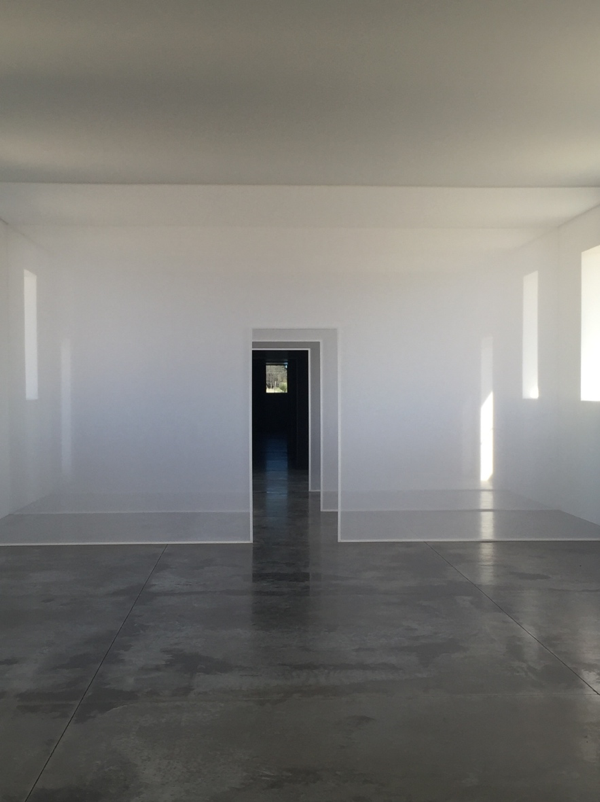
The founder’s work has been carried forward by two cooperating foundations – The Donald Judd Foundation displays his work in two downtown buildings known as The Block, and the Chinati Foundation, located on the former D.A. Russell Army Base at the edge of town is where the concrete boxes and barracks installations are located.
As you might imagine, in a town devoted to high concept art there are also a couple of good restaurants. On the day we were there, Anthony Bourdain was filming his Parts Unknown series on CNN. We just missed him at the Hotel Saint George bar and later at the Chinati site where M heard his crew was considering us as extras.
Anthony Bourdain obviously knew Marfa had food worth chasing down, and though we didn’t cross paths with him again we found a local bistro called Cochineal that I’m sure he visited. It’s a busy place and we were turned away on the Night One but able to get a reservation for Night Two. They serve main courses too but most of the diners choose to share tapas plates with an assortment ranging from duck breast to chili shrimp and roasted beet salad. Delicious.
I hadn’t paid much attention to the hype, but as we were leaving the restaurant Gar suggested we drive out of town to a location where locals claim an atmospheric phenomenon known as Marfa Lights can be seen on special occasions. I thought we would pull off the road somewhere and scan the horizon but was surprised to find a parking lot full of cars and a structure in place to accommodate the many curious viewers. We were unsuccessful that night but Sterry, our guide, claimed to have seen them many times. Maybe we’ll get lucky next time.
Next stop – McDonald Observatory just north of Fort Davis for a tour and Star Show.







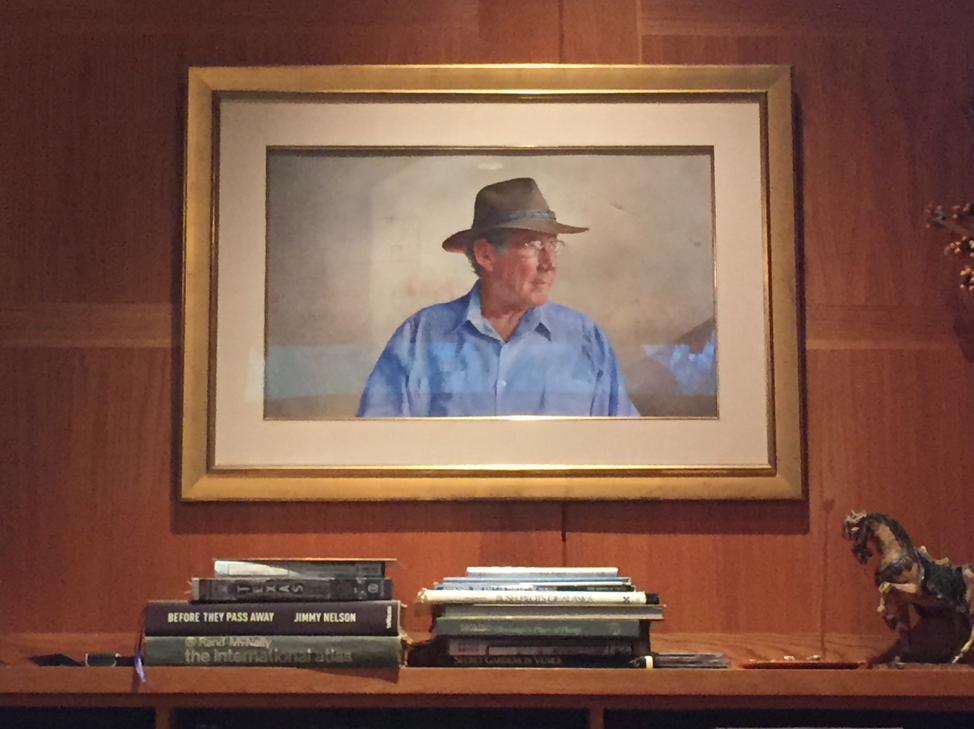
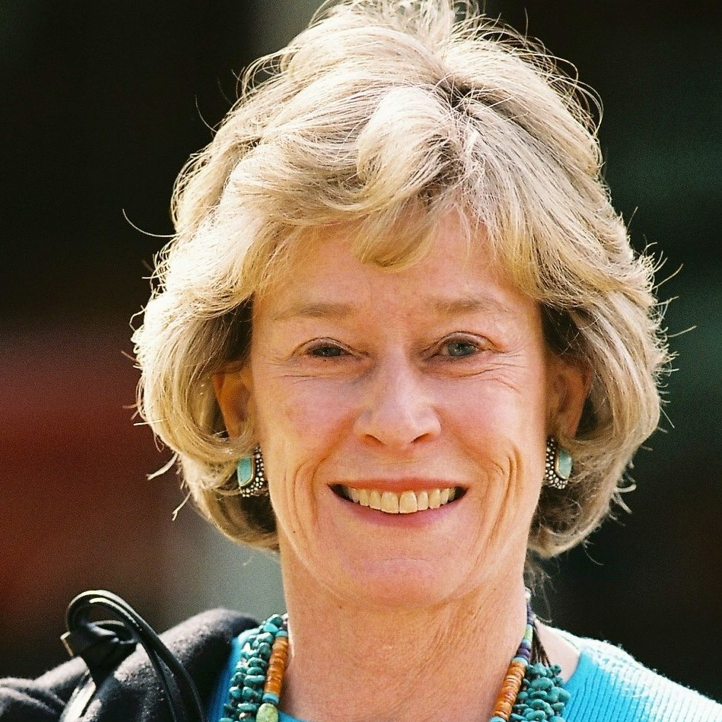 I hadn’t seen Garland in over ten years, and Marilynn had never met him or his wife, Mollie (left), a force all her own and the main event in a future blog. Standby for Mollie’s story and how old Texas blends with the Ivy League and cutting edge educational philanthropic commitment.
I hadn’t seen Garland in over ten years, and Marilynn had never met him or his wife, Mollie (left), a force all her own and the main event in a future blog. Standby for Mollie’s story and how old Texas blends with the Ivy League and cutting edge educational philanthropic commitment.